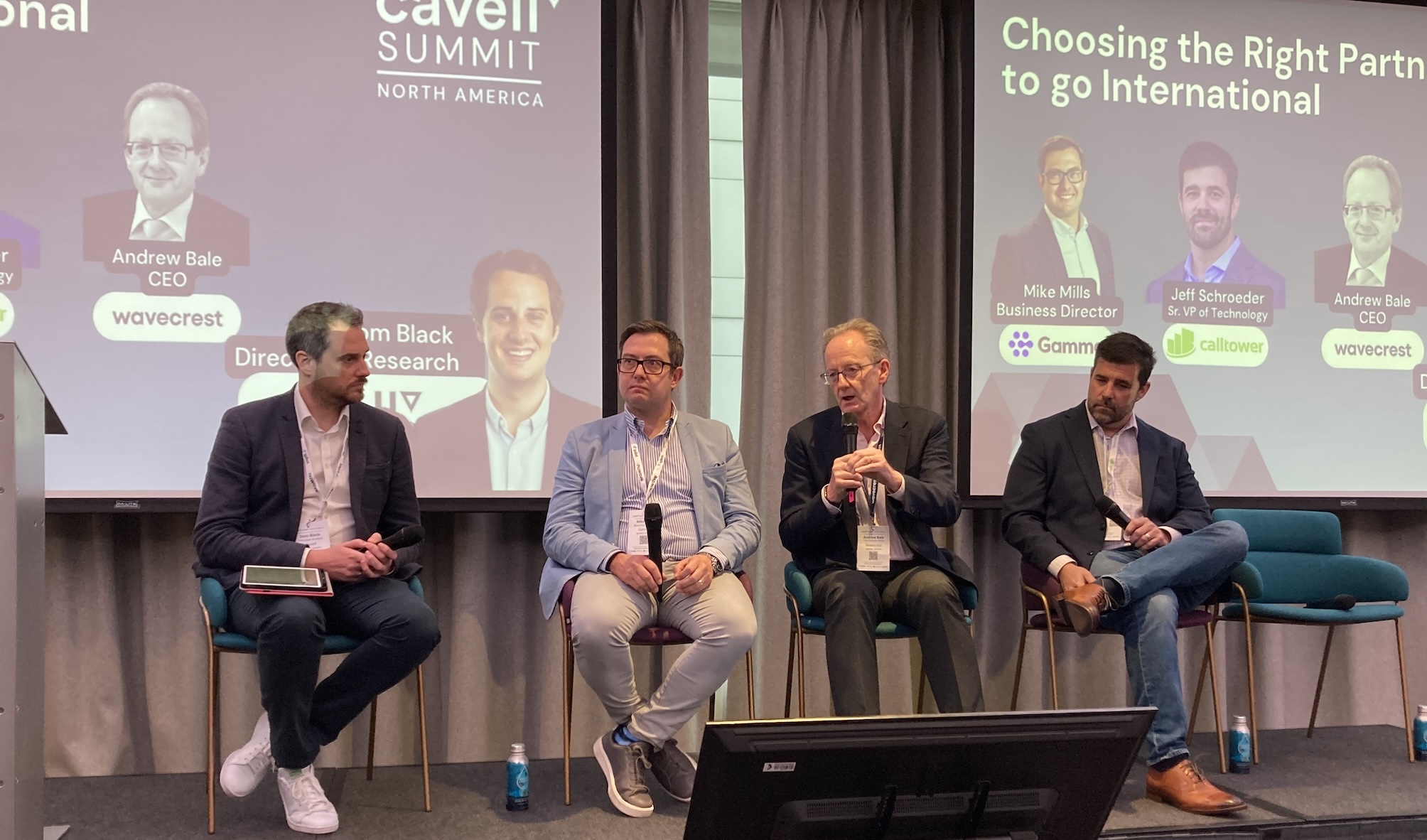Blog post
The LATAM telco landscape: a Q&A guide
06/27/24
Chris Adams
The Latin American region (LATAM) is one of the most interesting parts of the world in the telecoms sector right now. At Wavecrest, we’re taking a different approach and proactively building out our presence in LATAM – as part of our unrivalled global coverage offering.

1. The global cloud services market, which was valued at $551.8bn in 2021, looks set to quintuple in size to $2.5 trillion by 2031. What role is the Latin America region (LATAM) playing in that growth?
We’re witnessing a generational shift in the telco industry, as we bring together new cloud-based services with traditional telecoms architecture and the communications methods people know and love.
That dynamic is playing out slightly differently in each region around the world. As developed markets become mature, more and more attention in the industry is turning to the faster-growing developing regions. This is where LATAM comes in.
From a broad economic perspective, LATAM is attractive as a region of relatively fast growth. It’s bounced back well from the pandemic. Regional GDP will increase around 2.5% per annum over the next few years. Argentina is forecast to grow even faster, by between 4-5% per annum in 2025 and 2026. In a climate where Europe will be lucky to see 1% growth, you can see why LATAM becomes appealing.
From a global telco sector perspective, what makes LATAM especially interesting is its geographical proximity to North America. For many North American providers, LATAM is seen as their obvious next growth opportunity – the place to make their next investment and expand internationally. That drives a lot of focus on LATAM.
2. Digging more into the telco industry perspective, what’s the situation on the ground in LATAM?
LATAM is a region where modern telecoms infrastructure is fuelling a lot of growth. There isn’t a huge amount of legacy infrastructure there. It’s generally a mobile-first environment, like many developing markets, and there’s already some 5G roll-out too. That makes it easier for operators to get involved.
There’s also a lot of modern working practices around the region, especially in more sophisticated economies like Brazil and Argentina. There’s a fair amount of working from home in LATAM, for example.
That’s driving quite a rapid move away from legacy, on-premise communications platforms. It’s actually happening faster than in the more established Western markets.
We’re seeing many LATAM companies consolidating with a single cloud-based solution, combining all of the enterprise voice services they need. One cloud-based, collaboration-first platform, where ensuring the trustworthiness of mobile communications is critical.
That plays to our strengths at Wavecrest. Our model is about enabling a strong relationship between regulated, best-of-breed, in-country operators and cloud-based communications providers. That’s perhaps more important in LATAM than almost anywhere else.
Given the regulatory challenges across the region, the difficulties in providing numbering services, and the demand for integrated cloud-based platforms, we think our model is absolutely right for the conditions in LATAM.
3. How able are cloud services providers to seize the opportunity presented by emerging markets such as LATAM right now?
LATAM is a difficult market because of the regulatory complexity across the region. There’s no pan-region harmonisation like in the EU – every country in LATAM has its own rules and regulations.
In fact, I’d go so far as to say that the variation in regulatory approach is probably broader across LATAM than in any other region. The political and economic history of each country means that, overall, there are a very wide range of approaches, from the heavy-handed to the laissez faire. It’s pretty challenging to operate effectively with all of those different regulatory regimes.
All of that has historically meant there aren’t many global providers with a strong presence in the region. There aren’t many players offering global numbering services there, for instance.
4. Are there other reasons why provisioning voice services in LATAM is a particular issue for cloud services providers?
The other aspect – from an infrastructure perspective – is the sheer size of LATAM. It’s obviously a geographically large region, and that means quite long hop times between different parts of the continent. A mixture of investment cost and unavoidable physics makes the region more challenging than most.
There isn’t a huge amount of other infrastructure to rely on either. There’s only one AWS data centre for the whole of LATAM, for example. Some providers will put a data centre in Miami and say that means they cover LATAM! Its no wonder the GSMA talks about “the mobile connectivity gap” in LATAM.
We’re taking a very different, LATAM-centric approach. We’re building out a multi-tier approach, with dense Point of Presence locations distributed quite broadly around the region. That helps us keep calls as local as possible, which is important for data sovereignty requirements in some countries too.
It takes architecture, design, investment, and partnerships to do this properly. That can be difficult for many providers when LATAM tends still to be a relatively small part of their customer footprint. But it’s a key part of our global coverage offering and our approach to bringing the different parts of the new telco ecosystem together.
5. Is voice an area they really need to worry about?
It absolutely is. Because even though lots of companies are trying to modernise their enterprise infrastructure into a single communications flow, voice is still a very important part of that.
Specifically, a voice call still tends to be where the customer interaction begins. The customer will call you – especially in a mobile-led region like LATAM – and then the interaction might shift to text or digital.
So you have to create an environment where all of those comms modes can exist together. But voice is typically the anchor – it’s where people start from and how we can identify and authenticate them.
That’s reflected in the data from LATAM too. While wholesale voice is declining about 5% annually around the world, in LATAM wholesale voice is on a growth trajectory, up about 3% per year in terms of calls and much more than that in terms of minutes. This is representative of more CSPs collaborating on voice calls.
6. How much of an issue is fraud when CSPs are looking to offer services in LATAM?
Today any new service that’s about the international delivery of voice calls into domestic markets must recognise that this is a major vector for potential fraud. It must be handled well.
There’s no argument that LATAM is more likely to be attacked or to generate fraud than anywhere else. But wherever you wish to participate in the voice market, fraud is an issue.
At Wavecrest we think of it quite simply – when it comes to telco fraud, you’re either part of the problem or you’re part of the solution. Our model is built to tackle fraud as one of the existential issues in our industry, and that applies to LATAM just as much as anywhere else.
Some LATAM countries have been very active in this space too, which is encouraging. Brazil is the biggest market in LATAM by far, and last year three mobile operators there launched anti-fraud network services, while the regulator took action to reduce abusive calls.
7. How is Wavecrest addressing these challenges for CSPs?
We believe in three things that we offer to CSPs.
First, we believe regulatory transparency. This is particularly important in LATAM, as I’ve already explained. Given the complexities of regulation across the region, it’s critical to build open and transparent relationships between carriers and CSPs to foster trust and ensure compliance at all times.
Second, we believe in a territorial focus – that is, having a complete solution for a territory rather than saying we can source numbers in individual countries. As part of this, we’re committed to building the required infrastructure – that dense interconnect in each country, with lots of carrier relationships, and a multi-cloud approach – so we have better coverage and reach across LATAM.
Third, we believe in a commercial framework that’s very simple for companies providing global services. We appreciate that most customers won’t only have a LATAM focus, it’ll be part of their overall global expansion. So we provide one global trunk, and our customers can consume numbers from any of our served regions – from LATAM, Europe, or anywhere else – rather than having separate trunks for each number and each country. That makes it easier to enter global expansion, without the complexity that too often comes with operating in multiple territories.
8. What is different in the way you are tackling this than other providers of voice services?
Instead of regulatory transparency, we find others say they can provide numbers in a given country. But actually the provenance of those numbers – and thus the regulations applicable to them – is often hidden from the CSP. That is dangerous and unsound from a regulatory point of view. It puts the future of that number at risk, not to mention the relationship between the parties.
Instead of territorial focus, we find there tends to be a lack of investment from other providers. They might have picked off one rangeholder and one country, say, but that’s it. That doesn’t give a solid foundation for future growth.
And instead of a strong commercial framework, we often find quite complex pricing structures, requiring long commitments, and varying from country to country. It’s very hard to build business plans around this and feel confident in the years ahead.
Related Resources

Choosing the right partner to go International
Choosing the right partner has never been more challenging but our industry collectively needs to focus on transparency, trust and processes that bring safety back to the consumer.
Read more >
Are US telcos surcharged?
Origin-based rating (OBR) was introduced to reset the financial balance between different countries within the EEA. As the US isn’t an expensive destination, US telcos typically don’t expect to be classed as an expensive origination so are they surcharged?
Read more >